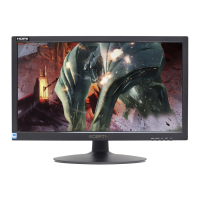If you are using VGA: To stabilize and clarify your display, use the
AUTO ADJUST function or change the resolution to the display’s
optimal setting 1600x900 at 60Hz, then AUTO ADJUST.
If you are using HDMI: Make sure your resolution is set to 1600x900.
Any other resolution will be slightly blurrier.
Check your video cable. It might be corrupt. Swap out the video cable
for another one to see if the monitor will work. Check your power plug.
See if it is fully plugged in on both the monitor and the wall. Check
your computer. See if it is turned on.
If you have a CRT monitor, please connect the CRT monitor to the
computer and change the refresh rate down to 60 Hz via your video
card’s display settings menu. After the setting of 60 Hz has been
change you can then use the LED on the computer.
1. To change the setting go to display settings by right clicking
on your desktop with nothing selected. Choose the
PROPERTIES option.
2. Click on the SETTINGS tab, verify the resolution is NOT
higher than 1600x900, and click on the ADVANCED button.
3. Click on the MONITOR tab and change the refresh rate to
60 Hz.
4. Click on OK 2-3 times to finalize your change.
If you do NOT have a CRT monitor or it’s already broken, please make
sure both the E20 LED monitor and your computer is turned off.
1. Turn on the LED monitor and the computer.
2. While the computer is turned on, press the “F8” key on your
keyboard continuously until a selection menu appears and
select the “Safe Mode” option.
3. When you’ve entered Safe Mode please uninstall any video
card driver and monitor driver by using either the “Add /
Remove Programs” icon or going into “System
4. Properties” and manually removing anything under
“Monitors” and “Display Adapters”. After removing all the
drivers, please reboot your computer and you should be
able to see windows. Please install your monitor driver
first, then your video card driver. Please remember to
make sure your refresh rate should be at 60Hz.

